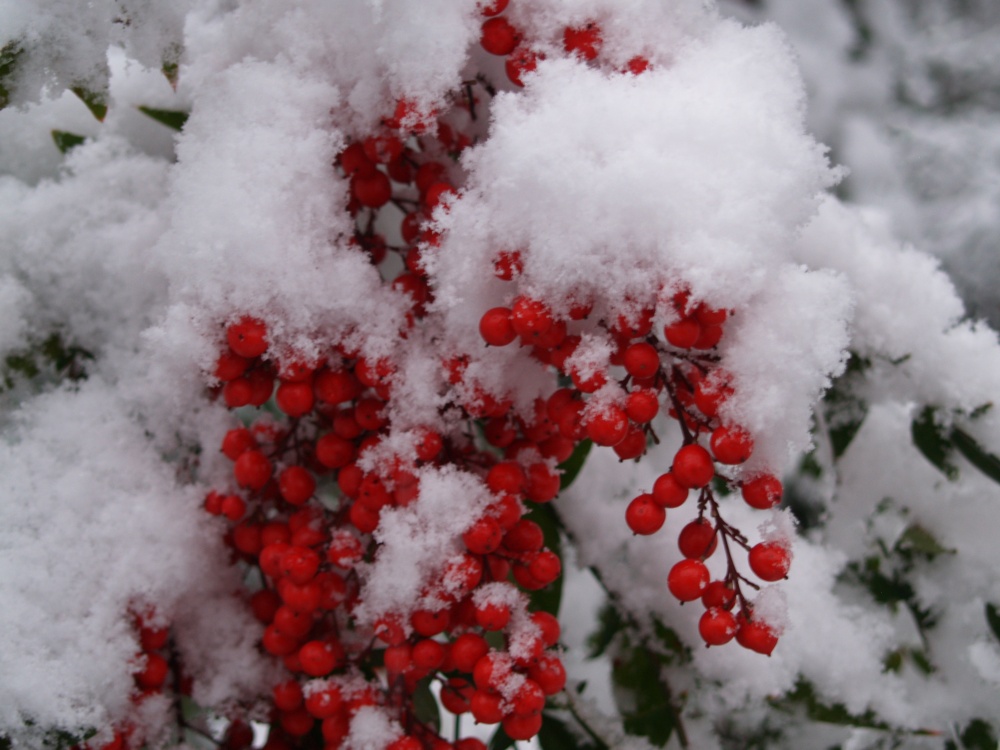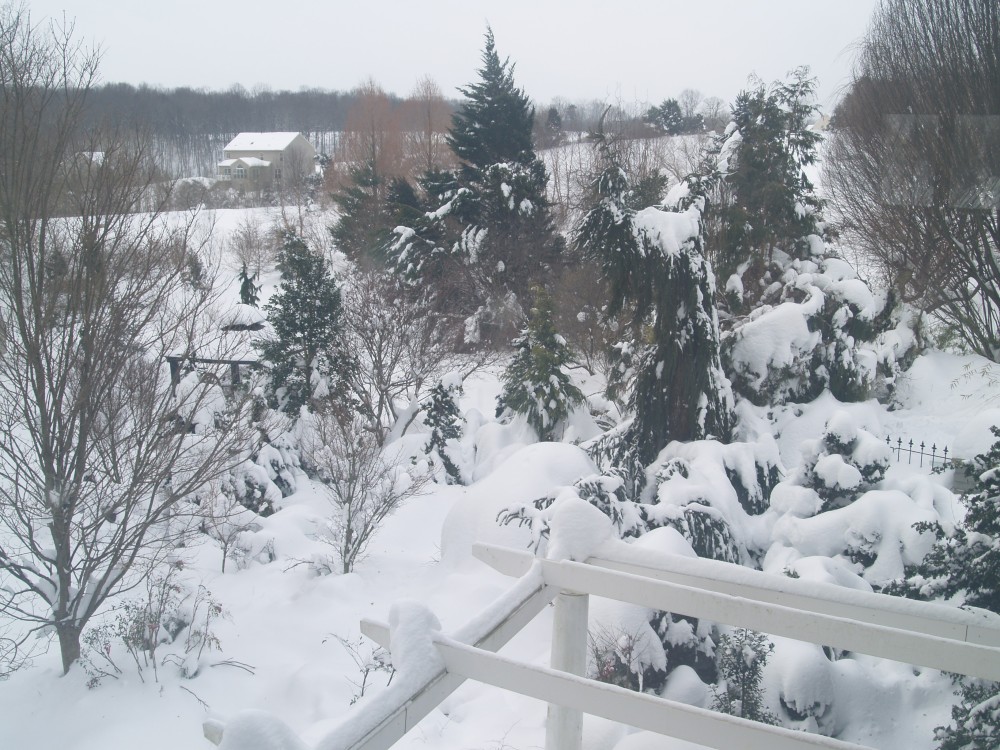Note – The following post is reprinted with minor revisions from March 2013. Due to temperatures hovering just below freezing, the snow forecast for this weekend is expected to be wetter, and thus heavier. A wet snow tends to cling to branches, accumulating more quickly, and increasing the urgency in removing snow from vulnerable trees and shrubs. The most pertinent recommendations in this post have been highlighted.
If there are significant snow accumulations I will add updates through the weekend and link to older posts that addressed repairs to damaged trees and shrubs. I will also be available for questions and comments (as long as the electricity doesn’t cut out).
Long before daylight this morning several inches of snow had fallen, and the worst of the storm is still to come. When I first went outside in the dark I was alerted to the problems ahead. Limbs of the wide spreading ‘Seriyu’ Japanese maple planted just off the corner of the garage were weighed down by snow accumulating in the dense branches to block half of the opening of the garage. As I looked across the garden the reflected light off the blanket of snow showed trouble in every direction.
Boxwoods and nandinas have been flattened by the heavy, wet snow, and crapemyrtle trunks fifteen feet tall are arched to nearly touch the ground. Unfortunately, I’ve seen this before. Now, with only four or five inches of snow there are problems. What will happen with another six, or eight, or ten inches still to come?
With colder temperatures and light, fluffy snow there is usually nothing to worry about. The wind blows, and the snow slowly drifts to the ground. But, wet snows accumulate quickly in evergreens and densely branched plants. Once the branches are bent the real danger is that they will break, and in winter storms several years ago my garden suffered substantially due to too little action, too late. Also, branches of trees and shrubs that remain bent will often loose their rigidity if allowed to remain too long, so that when the snow is gone the branches do not spring back. Many times these will require severe pruning or other actions to repair the damage.
Here’s how I plan to spend my day (after finishing this brief update).
Before the heavier snow causes more damage I’ll go outside, armed with a leaf rake. The process is not complicated from here. A gentle nudge with the rake is all that’s needed to dislodge most of the accumulated snow. Greater force can cause more damage, and most often it isn’t necessary. If winds pick up later in the day that might help to clear additional snow, but if the heavy snow that weighs the branches is allowed to remain the breezes could cause greater injury.
I’ll work on deciduous trees like the Japanese maples and crapemyrtles first, since these are most easily damaged. Japanese maples, in particular, are soft wooded with branching that is readily damaged by snow. Weeping varieties of Japanese maples are most vulnerable with a thick canopy of branches that collect the heavy snow. Extra care should be used in clearing the snow from these maples to avoid injury.
Once the branches are nudged with the rake the snow falls to the ground, and the branch usually springs back, though not all the way. This is rarely a concern when the branches have been bent for only a few hours, and I’ll worry about that another day since there’s little that can be done today. It’s not necessary to remove every bit of snow from branches, though the snow that remains will catch more of the wet snow that is predicted for later in the morning. My first snow clearing trip around the garden will probably be one of several today.
After the deciduous trees I’ll work on evergreens next, and follow that with smaller evergreen shrubs like the boxwoods and nandinas that have more flexible branches and often spring back quickly. Several years ago evergreen southern magnolias and Leyland cypresses were severely damaged in consecutive winters. A single tall cypress in my garden was bent to a severe angle and was removed. The southern magnolias have grown back remarkably, but now their form is much more wide spreading since the broken trunks resulted in more horizontal growth. I’m afraid that this will only encourage more snow to accumulate in the branches, so these will be the first evergreens to be checked.
I have a large garden, with dozens of Japanese maples and small trees scattered over the acre and a quarter property, so this task will require constant vigilance today. What happens if I ignore the snow, and see what happens? I’ve done that before, and in prior years when substantial snow falls overnight the damage is already done before I wake up.
Most often I have a casual attitude about garden chores. If I don’t pull weeds, they’ll still be there tomorrow (though they might have dropped a few thousand seeds in the meanwhile). Many garden chores can be put off, but a delay in removing snow from branches can cause irreparable damage to plants. So, I’m wrapping up my writing, grabbing my leaf rake, and heading outside. Also, while I’ve been writing it’s become light enough to see that the pace of snowfall has increased. The breeze has picked up and large clumps of snow are falling out of the tall tulip poplars and maples that border the garden.
The process of removing snow from trees and shrubs should not be vigorous exercise, and certainly is nothing compared to the labor of shoveling the driveway and walk. But, take care not to over exert, and if you are working in an area with tall trees be aware that branches could come down at any time. Avoiding damage to the plants in the garden is a much lesser concern than your personal safety, so be careful.

I hope your garden doesn’t suffer too much. It sounds like you are on top of things. Good luck and take care. I enjoy reading your posts.
If I’m on top of things it will be the first time.
Thank you for this post! This is my first winter caring for this substantial garden, and we are in for a “big storm” this weekend, and now I have an idea how to cope.
I’m happy to answer any specific questions during or after thee storm. If the storm drops the amount of snow that is predicted I am likely to add more information.